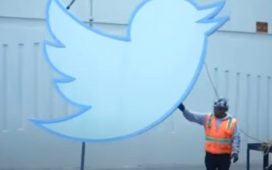Browsing through a history of online public messaging last week, I came across a magical photograph from 1989 or 1990. It shows the world’s first web server. It was Tim Berners-Lee’s NeXT workstation in Cern, the international physics research lab, where he worked at the time. On the case is a tattered sticky label, on which is scribbled, in red ink, “This machine is a server DO NOT POWER IT DOWN!!”
Berners-Lee, a British computer scientist, had come up with the idea for a “world wide web” as a way of locating and accessing documents that were scattered all over the internet. With a small group of colleagues he envisaged, designed and implemented it in the late 1980s and eventually put the whole thing – protocols, server and browser software, HTML specification, etc. – on one of Cern’s internet servers, and in doing so changed the world.
He was able to do this because the internet, which had been publicly available since January 1983, enabled it. The network had no central ownership or controller; and it did only one thing – transfer data packets from one edge of the network to their destination at another edge. If you were smart enough to build an application that used data packets, then the internet would do it for you, no questions asked.
The result was an extraordinary explosion of creativity, and the emergence of what was, essentially, a kind of global commons. At that point in its history, the internet was, as one scholar later described it, “an architecture for permissionless innovation” or, more prosaically, a global machine for springing surprises. The first such surprise was the web. And because it was decided the web would grow better without profit considerations, Berners-Lee released it as a platform that would also enable permissionless innovation.
However, the next generation of innovators to benefit from this freedom – Google, Facebook, Amazon, Microsoft, Apple et al – saw no reason to extend it to anyone else. They built fabulously profitable enterprises on the platform that Berners-Lee had created. The creative commons of the internet has been gradually and inexorably enclosed, much as agricultural land was by parliamentary acts from 1600 onwards in England.
The result, as Maria Farrell and Robin Berjon put it in a striking essay in Noema magazine, is that our online spaces are no longer open ecosystems. Instead “they’re plantations; highly concentrated and controlled environments, closer kin to the industrial farms that madden the creatures trapped within”.
after newsletter promotion
And these industrial farms have concentrated into a series of duopolies. Google and Apple’s browsers have nearly 85% of the world market share. Microsoft and Apple’s two desktop operating systems have almost 90%. Google runs about 90% of global search. More than half of all phones come from Apple and Samsung, while 99% of mobile operating systems are from Google or Apple. Apple and Google’s email clients manage nearly 90% of global email. GoDaddy and Cloudflare serve about 50% of global domain name system requests. And so on.
One of the consequences of this concentration, say Farrell and Berjon, is that the creative possibilities of permissionless innovation have become increasingly constrained. “Two kinds of everything may be enough to fill a fictional ark,” they write, “but can’t run an open, global ‘network of networks’ where everyone has the same chance to innovate.”
“The internet”, Eric Schmidt, former chairman of Google, famously observed, “is the first thing that humanity has built that humanity doesn’t understand, the largest experiment in anarchy that we have ever had.” Since Dr Schmidt once ran the Google plantation, what he regards as anarchy is doubtless what ecologists would call diversity.
And of course for a plantation owner, diversity is a bug, not a feature. Farrell and Berjon make intriguing use of this metaphor. Their essay opens with an account of the notion of “scientific forestry” took hold in late 18th century Prussia and Saxony when officials began to rearrange their complex, diverse forests into straight rows of single-species trees: “Owners no longer relied on skilled local foresters to manage forests. They were replaced with lower-skilled labourers following basic algorithmic instructions to keep the monocrop tidy, the undergrowth bare.”
You can guess how this panned out. The first felling of the tidy trees yielded vast profits. Fresh trees were then planted, but were attacked by pests and disease. “The first magnificent bounty,” write Farrell and Berjon, “had not been the beginning of endless riches, but a one-off harvesting of millennia of soil wealth built up by biodiversity and symbiosis. Complexity was the goose that laid golden eggs, and she had been slaughtered.” As we Irish discovered in the great famine of 1845-49, monocultures are generally not a good idea and we abandon biodiversity at our peril.
Farrell and Berjon make the same point about our online world: the internet has become an extractive and fragile monoculture. We can revitalise it, but only by “rewilding” it – hence the title of their essay. I guess it will be as attractive to Silicon Valley as George Monbiot is to the National Farmers’ Union.










